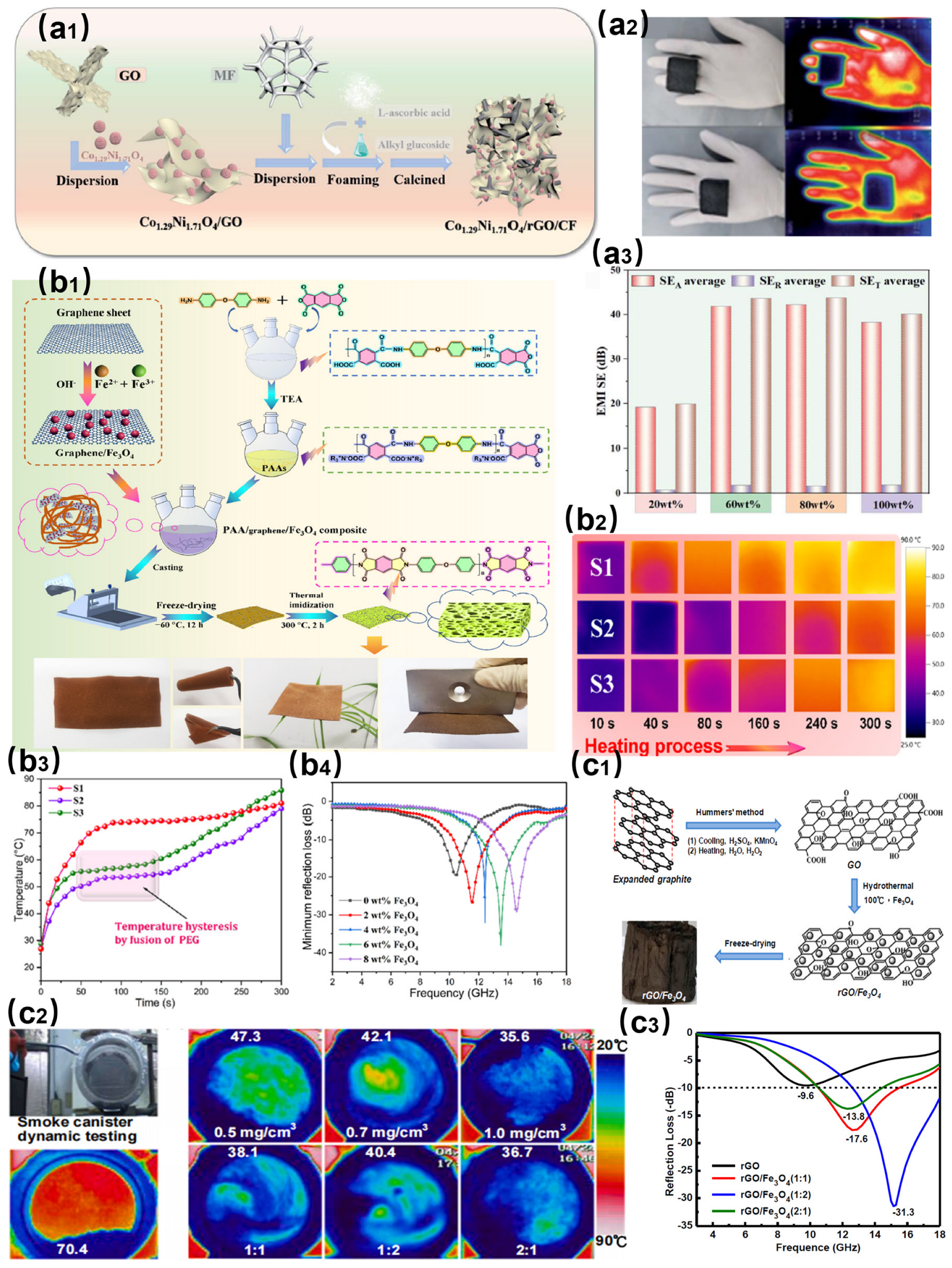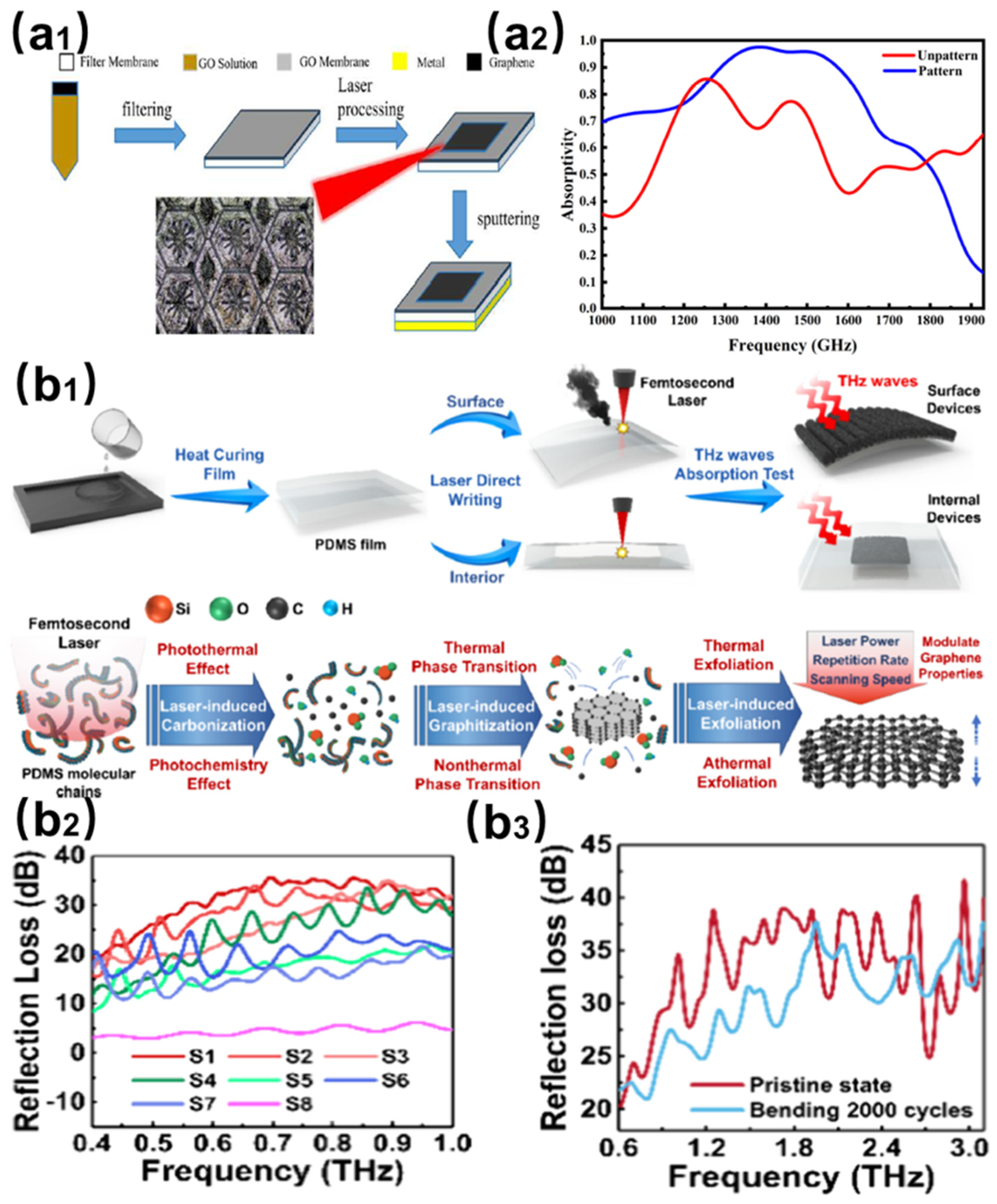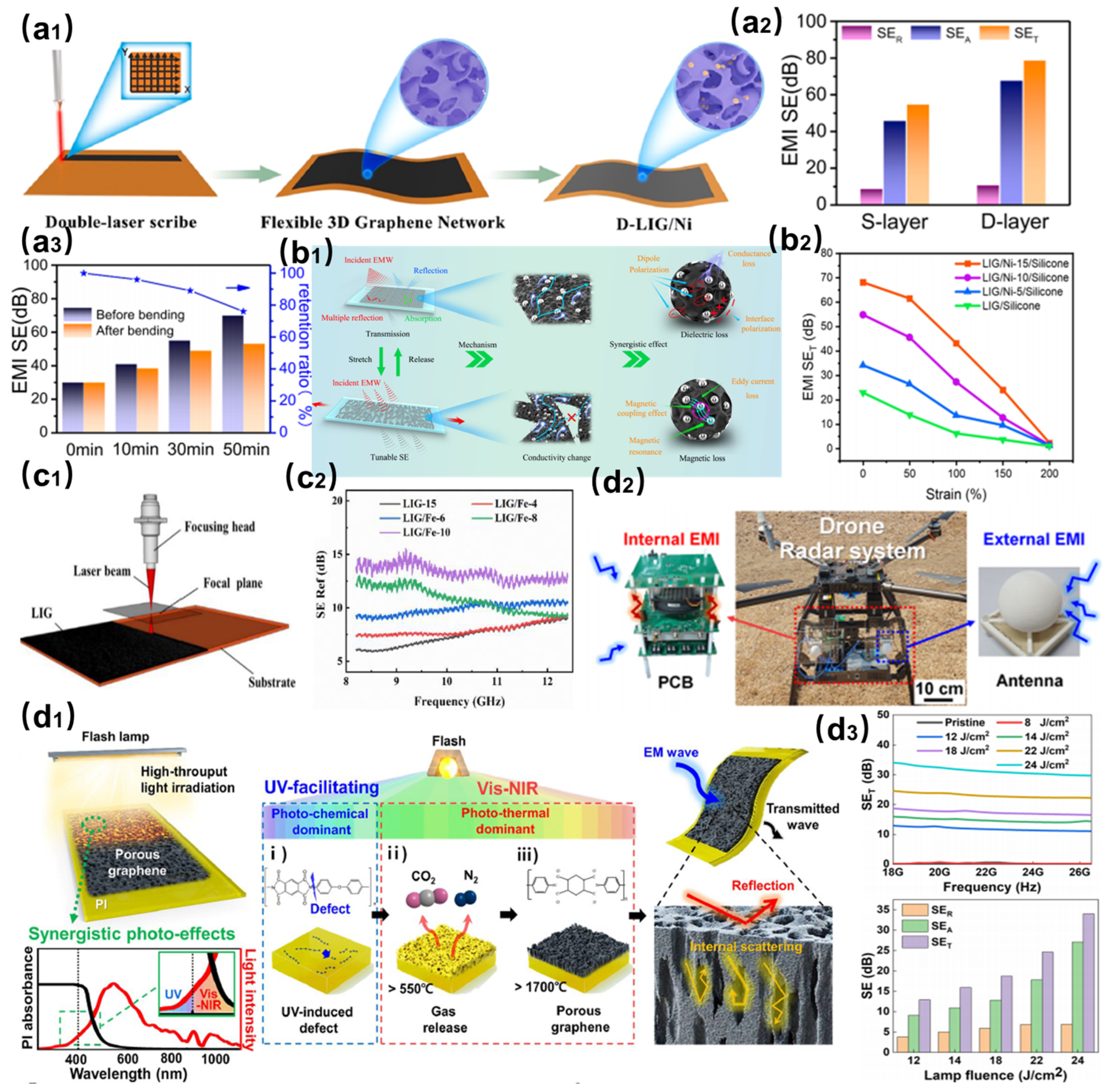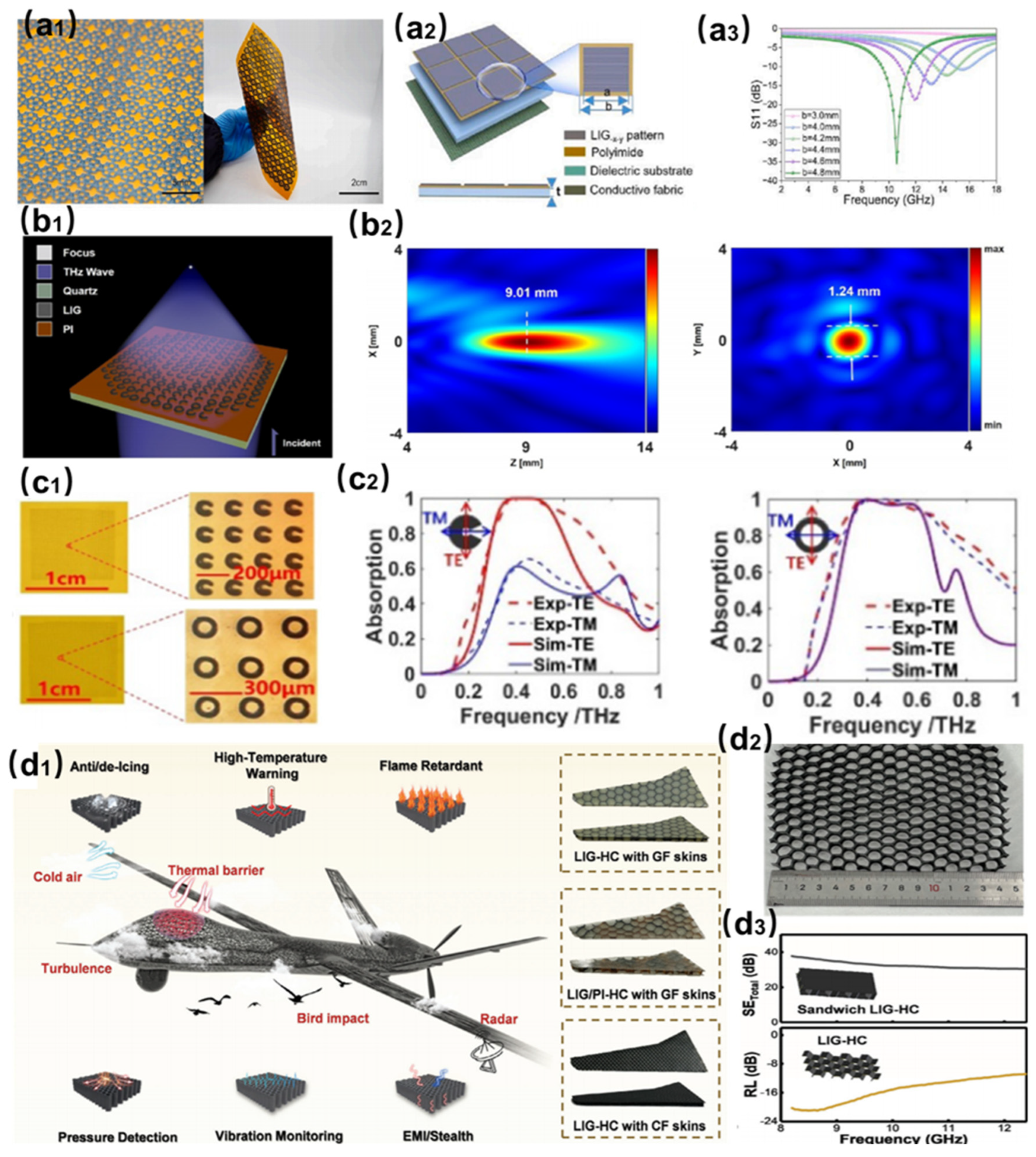Stealth Materials Based on Laser-Induced Graphene: Developments and Challenges
Abstract
:1. Introduction
2. Electromagnetic Shielding Mechanism of Three-Dimensional Porous Conducting Structures Represented by Laser-Induced Graphene
2.1. Electrical Conductivity and Ohmic Loss
2.2. Magnetic Permeability and Magnetic Loss
2.3. Porosity and Multiple Reflections/Scattering
2.4. Defects/Doping and Polarization Loss
2.5. Multilayer Structure Dissipation
3. Recent Research on LIG-Based Electromagnetic Stealth Materials
3.1. LIG-Based Multispectral Absorbing Material
3.2. LIG-Based Broadband Absorbing Material
3.3. LIG-Based Metasurface and Smart Cells
4. Challenges and Outlook
Author Contributions
Funding
Data Availability Statement
Conflicts of Interest
Abbreviations
| LIG | laser-induced graphene |
| EMI | electromagnetic interference |
| SER | reflection loss |
| SEA | absorption loss |
| SET | total shielding effectiveness |
| SEM | multiple reflection loss |
| FSS | frequency-selective surfaces |
| EAB | effective absorption bandwidth |
| LIG-HC | LIG-based honeycombs |
| MAs | metamaterial absorbers |
| NPs | nanoparticles |
| PDMS | polydimethylsiloxane |
| CST | cell signaling technology |
| GEMN | graphene-encapsulated magnetic nanoalloy |
| LITEN | laser-induced thermochemical transformation and nanoalloy encapsulation |
References
- Gao, T.; Ma, Y.; Ji, L.; Zheng, Y.; Yan, S.; Li, Y.; Zhang, X. Nickel-coated wood-derived porous carbon (Ni/WPC) for efficient electromagnetic interference shielding. Adv. Compos. Hybrid Mater. 2022, 5, 2328–2338. [Google Scholar] [CrossRef]
- Kim, S.H.; Lee, S.Y.; Zhang, Y.; Park, S.J.; Gu, J. Carbon-based radar absorbing materials toward stealth technologies. Adv. Sci. 2023, 10, 2303104. [Google Scholar] [CrossRef]
- Zhang, Y.; Gu, J. A perspective for developing polymer-based electromagnetic interference shielding composites. Nano-Micro Lett. 2022, 14, 89. [Google Scholar] [CrossRef] [PubMed]
- Shi, S.; Si, Y.; Han, Y.; Wu, T.; Iqbal, M.I.; Fei, B.; Li, R.K.; Hu, J.; Qu, J. Recent progress in protective membranes fabricated via electrospinning: Advanced materials, biomimetic structures, and functional applications. Adv. Mater. 2022, 34, 2107938. [Google Scholar] [CrossRef]
- Zhang, S.; Zhang, S.; Zhu, P.; Li, J.; Li, Y.; Zhou, C.; Qiu, Q.; Jing, X.; Paik, K.-W.; He, P. Recent achievements and performance of nanomaterials in microwave absorption and electromagnetic shielding. Adv. Colloid Interface Sci. 2024, 335, 103336. [Google Scholar] [CrossRef]
- Thomassin, J.-M.; Jérôme, C.; Pardoen, T.; Bailly, C.; Huynen, I.; Detrembleur, C. Polymer/carbon based composites as electromagnetic interference (EMI) shielding materials. Mater. Sci. Eng. R Rep. 2013, 74, 211–232. [Google Scholar] [CrossRef]
- Isari, A.A.; Ghaffarkhah, A.; Hashemi, S.A.; Wuttke, S.; Arjmand, M. Structural design for EMI shielding: From underlying mechanisms to common pitfalls. Adv. Mater. 2024, 36, 2310683. [Google Scholar] [CrossRef]
- Li, K.; Han, L.; Zhang, J.; Cheng, J. Metal-organic framework derived multidimensional carbon/multifluorination epoxy nanocomposite with electromagnetic wave absorption, environmentally adaptive, and blue energy harvesting. Small Struct. 2023, 4, 2300210. [Google Scholar] [CrossRef]
- Yao, L.; Wang, Y.; Zhao, J.; Zhu, Y.; Cao, M. Multifunctional nanocrystalline-assembled porous hierarchical material and device for integrating microwave absorption, electromagnetic interference shielding, and energy storage. Small 2023, 19, 2208101. [Google Scholar] [CrossRef]
- Wang, M.; Tang, X.-H.; Cai, J.-H.; Wu, H.; Shen, J.-B.; Guo, S.-Y. Construction, mechanism and prospective of conductive polymer composites with multiple interfaces for electromagnetic interference shielding: A review. Carbon 2021, 177, 377–402. [Google Scholar] [CrossRef]
- Xia, Y.; Gao, W.; Gao, C. A review on graphene-based electromagnetic functional materials: Electromagnetic wave shielding and absorption. Adv. Funct. Mater. 2022, 32, 2204591. [Google Scholar] [CrossRef]
- Liu, J.; Yu, M.-Y.; Yu, Z.-Z.; Nicolosi, V. Design and advanced manufacturing of electromagnetic interference shielding materials. Mater. Today 2023, 66, 245–272. [Google Scholar] [CrossRef]
- Wang, C.; Murugadoss, V.; Kong, J.; He, Z.; Mai, X.; Shao, Q.; Chen, Y.; Guo, L.; Liu, C.; Angaiah, S. Overview of carbon nanostructures and nanocomposites for electromagnetic wave shielding. Carbon 2018, 140, 696–733. [Google Scholar] [CrossRef]
- Chen, J.; Liu, Y.-L.; Sun, D.-X.; Qi, X.-D.; Yang, J.-H.; Wang, Y. Recent progress in structural design of graphene/polymer porous composites toward electromagnetic interference shielding application. Chem. Eng. J. 2024, 153586. [Google Scholar] [CrossRef]
- You, R.; Liu, Y.Q.; Hao, Y.L.; Han, D.D.; Zhang, Y.L.; You, Z. Laser fabrication of graphene-based flexible electronics. Adv. Mater. 2020, 32, 1901981. [Google Scholar] [CrossRef]
- Lin, J.; Peng, Z.; Liu, Y.; Ruiz-Zepeda, F.; Ye, R.; Samuel, E.L.; Yacaman, M.J.; Yakobson, B.I.; Tour, J.M. Laser-induced porous graphene films from commercial polymers. Nat. Commun. 2014, 5, 5714. [Google Scholar] [CrossRef]
- Avinash, K.; Patolsky, F. Laser-induced graphene structures: From synthesis and applications to future prospects. Mater. Today 2023, 70, 104–136. [Google Scholar] [CrossRef]
- Zhang, Z.; Zhu, H.; Zhang, W.; Zhang, Z.; Lu, J.; Xu, K.; Liu, Y.; Saetang, V. A review of laser-induced graphene: From experimental and theoretical fabrication processes to emerging applications. Carbon 2023, 214, 118356. [Google Scholar] [CrossRef]
- Liang, C.; Zhang, W.; Fan, Y.; Mei, Z.; Zhang, L.; Sun, Z.; You, R.; You, Z.; Zhao, X. On Demand Copper Electrochemical Deposition on Laser Induced Graphene for Flexible Electronics. Small 2025, 2408943. [Google Scholar] [CrossRef]
- Singh, S.P.; Li, Y.; Zhang, J.; Tour, J.M.; Arnusch, C.J. Sulfur-doped laser-induced porous graphene derived from polysulfone-class polymers and membranes. ACS Nano 2018, 12, 289–297. [Google Scholar] [CrossRef]
- Li, J.T.; Stanford, M.G.; Chen, W.; Presutti, S.E.; Tour, J.M. Laminated laser-induced graphene composites. ACS Nano 2020, 14, 7911–7919. [Google Scholar] [CrossRef] [PubMed]
- Su, R.; Liang, M.; Yuan, Y.; Huang, C.; Xing, W.; Bian, X.; Lian, Y.; Wang, B.; You, Z.; You, R. High-Performance Sensing Platform Based on Morphology/Lattice Collaborative Control of Femtosecond-Laser-Induced MXene-Composited Graphene. Adv. Sci. 2024, 11, 2404889. [Google Scholar] [CrossRef] [PubMed]
- Hong, S.; Kim, J.; Jung, S.; Lee, J.; Shin, B.S. Surface morphological growth characteristics of laser-induced graphene with UV pulsed laser and sensor applications. ACS Mater. Lett. 2023, 5, 1261–1270. [Google Scholar] [CrossRef]
- Du, B.; Lu, J.; Wang, G.; Han, M.; Gao, Y.; Luo, S. Combined laser-induced graphene and microcontact printing for processing scalable and stackable micro-stripe patterns toward multifunctional electronic devices. Carbon 2024, 225, 119148. [Google Scholar] [CrossRef]
- Liu, M.; Wang, Z.; Song, Z.; Wang, F.; Zhao, G.; Zhu, H.; Jia, Z.; Guo, Z.; Kang, F.; Yang, C. A popcorn-inspired strategy for compounding graphene@ NiFe2O4 flexible films for strong electromagnetic interference shielding and absorption. Nat. Commun. 2024, 15, 5486. [Google Scholar] [CrossRef]
- He, M.; Wang, Y.; Wang, S.; Luo, S. Laser-induced graphene enabled 1D fiber electronics. Carbon 2020, 168, 308–318. [Google Scholar] [CrossRef]
- Vandervelde, J.; Yoon, Y.; Shahriar, R.; Cronin, S.B.; Chen, Y. Additive and Laser Manufacturing for Multifunctional Electronics on High-Performance Polymers. Small Sci. 2025, 2500022. [Google Scholar] [CrossRef]
- Moon, H.-r.; Ryu, B. Review of Laser-Induced Graphene (LIG) Produced on Eco-Friendly Substrates. Int. J. Precis. Eng. Manuf.-Green Technol. 2024, 11, 1279–1294. [Google Scholar] [CrossRef]
- Babatain, W.; Park, C.; Ishii, H.; Gershenfeld, N. Laser-Enabled Fabrication of Flexible Printed Electronics with Integrated Functional Devices. Adv. Sci. 2025, 2415272. [Google Scholar] [CrossRef]
- Fu, X.-Y.; Zhang, Y.-Y.; Ma, C.-J.; Jiang, H.-B. Programmable patterning fabrication of laser-induced graphene-MXene composite electrodes for flexible planar supercapacitors. Opt. Lett. 2022, 47, 1502–1505. [Google Scholar] [CrossRef]
- Wei, Z.; Li, Z.; Chen, D.; Liang, J.; Kong, J. Recent Progress of Advanced Composites for Broadband Electromagnetic Wave Absorption. Small Struct. 2024, 2400615. [Google Scholar] [CrossRef]
- Anirudh, S.; Krishnamurthy, S.; Kandasubramanian, B.; Kumar, P. Probing into atomically thin layered nano-materials protective coating for aerospace and strategic defence application–A review. J. Alloys Compd. 2023, 968, 172203. [Google Scholar]
- Hu, D.; Huang, X.; Li, S.; Jiang, P. Flexible and durable cellulose/MXene nanocomposite paper for efficient electromagnetic interference shielding. Compos. Sci. Technol. 2020, 188, 107995. [Google Scholar] [CrossRef]
- Gao, Y.; Wang, Y.; Liu, S.; Zhong, S.; Yu, M.; Wang, C. Preparation of paraffin wax-modified floating aluminum powder and composite coating with infrared stealth and wave-transparent function. Mater. Sci. Eng. B 2023, 295, 116611. [Google Scholar] [CrossRef]
- Sun, H.; Yang, B.; Zhang, M. Functional–structural integrated aramid nanofiber-based honeycomb materials with ultrahigh strength and multi-functionalities. Adv. Fiber Mater. 2024, 6, 1122–1137. [Google Scholar] [CrossRef]
- Yin, J.; Zhang, J.; Zhang, S.; Liu, C.; Yu, X.; Chen, L.; Song, Y.; Han, S.; Xi, M.; Zhang, C.; et al. Flexible 3D porous graphene film decorated with nickel nanoparticles for absorption-dominated electromagnetic interference shielding. Chem. Eng. J. 2021, 421, 129763. [Google Scholar] [CrossRef]
- Yu, Z.; Yu, W.; Jiang, Y.; Wang, Z.; Zhao, W.; Liu, X. Upcycling of Polybenzoxazine to Magnetic Metal Nanoparticle-Doped Laser-Induced Graphene for Electromagnetic Interference Shielding. ACS Appl. Nano Mater. 2022, 5, 13158–13170. [Google Scholar] [CrossRef]
- Li, S.; Tang, X.; Zhang, Y.; Lan, Q.; Hu, Z.; Li, L.; Zhang, N.; Ma, P.; Dong, W.; Tjiu, W. Corrosion-resistant graphene-based magnetic composite foams for efficient electromagnetic absorption. ACS Appl. Mater. Interfaces 2022, 14, 8297–8310. [Google Scholar] [CrossRef]
- Su, J.; Zhang, X.; Ma, Z.; Xu, X.; Xu, J.; Chen, Y. Construction of Fe 3 C@ N-doped 3 C@ N-doped graphene layers yolk-shelled nanoparticles on the graphene sheets for high-efficient electromagnetic wave absorption. CARBON 2024, 229, 119448. [Google Scholar] [CrossRef]
- Cheng, L.; Yeung, C.S.; Huang, L.; Ye, G.; Yan, J.; Li, W.; Yiu, C.; Chen, F.-R.; Shen, H.; Tang, B.Z. Flash healing of laser-induced graphene. Nat. Commun. 2024, 15, 2925. [Google Scholar] [CrossRef]
- Sahoo, S.; Palai, R.; Barik, S.K.; Katiyar, R.S. Raman spectroscopic studies of pulsed laser-induced defect evolution in graphene. J. Raman Spectrosc. 2013, 44, 798–802. [Google Scholar] [CrossRef]
- Shi, Y.; Ding, X.; Pan, K.; Gao, Z.; Du, J.; Qiu, J. A novel multi-dimensional structure of graphene-decorated composite foam for excellent stealth performance in microwave and infrared frequency bands. J. Mater. Chem. A 2022, 10, 7705–7717. [Google Scholar] [CrossRef]
- Shi, T.; Zheng, Z.; Liu, H.; Wu, D.; Wang, X. Configuration of Multifunctional Polyimide/Graphene/Fe3O4 Hybrid Aerogel-Based Phase-Change Composite Films for Electromagnetic and Infrared Bi-Stealth. Nanomaterials 2021, 11, 3038. [Google Scholar] [CrossRef] [PubMed]
- Wu, K.-H.; Huang, W.-C.; Wang, J.-C.; Hung, W.-C. Infrared stealth and microwave absorption properties of reduced graphene oxide functionalized with Fe3O4. Mater. Sci. Eng. B 2022, 276, 115575. [Google Scholar] [CrossRef]
- Houeix, Y.; Romero, F.J.; Ruiz, F.G.; Morales, D.P.; Rodriguez, N.; Kaddour, D. Thin Microwave Absorber Based on Laser-Induced Graphene Frequency Selective Surfaces. IEEE J. Radio Freq. Identif. 2024, 8, 168–175. [Google Scholar] [CrossRef]
- Huang, Y.; Li, Y.; Pan, K.; Fang, Y.; Chan, K.C.; Xiao, X.; Wei, C.; Novoselov, K.S.; Gallop, J.; Hao, L.; et al. A direct laser-synthesized magnetic metamaterial for low-frequency wideband passive microwave absorption. Int. J. Extrem. Manuf. 2023, 5, 035503. [Google Scholar] [CrossRef]
- Zhang, S.; Rao, S.; Li, Y.; Wang, S.; Sun, D.; Liu, F.; Cheng, G.J. Laser-forged transformation and encapsulation of nanoalloys: Pioneering robust wideband electromagnetic wave absorption and shielding from GHz to THz. Int. J. Extrem. Manuf. 2024, 6, 055501. [Google Scholar] [CrossRef]
- Wu, H.; Bian, X.; Liang, M.; You, R. Broadband Terahertz Metamaterial Absorber Based on Laser Reduced Graphene Oxide Films. In Proceedings of the 2024 IEEE Sensors, Kobe, Japan, 20–23 October 2024; pp. 1–4. [Google Scholar]
- Huang, C.; Liang, M.; Wang, B.; Su, R.; Feng, Y.; Xing, W.; Zhao, X.; Bian, X.; You, Z.; You, R. In Situ Laser-Induced 3D Porous Graphene within Transparent Polymers for Encapsulation-Free and Tunable Ultrabroadband Terahertz Absorption. ACS Appl. Mater. Interfaces 2024, 16, 26557–26567. [Google Scholar] [CrossRef]
- Ge, H.; Gao, D.; Zhang, S.; Liu, C.; Chen, L.; Song, Y.; Li, Z.; Hong, N.; Kang, J.; Song, Z.; et al. Regulating the Conductive Network of Graphene/Ni Composite Films toward Tunable Electromagnetic Shielding Efficiency. ACS Appl. Mater. Interfaces 2024, 16, 68144–68156. [Google Scholar] [CrossRef]
- Yu, W.; Peng, Y.; Cao, L.; Zhao, W.; Liu, X. Free-standing laser-induced graphene films for high-performance electromagnetic interference shielding. Carbon 2021, 183, 600–611. [Google Scholar] [CrossRef]
- Lee, J.S.; Kim, J.-W.; Lee, J.H.; Son, Y.K.; Kim, Y.B.; Woo, K.; Lee, C.; Kim, I.-D.; Seok, J.Y.; Yu, J.W.; et al. Flash-Induced High-Throughput Porous Graphene via Synergistic Photo-Effects for Electromagnetic Interference Shielding. Nano-Micro Lett. 2023, 15, 191. [Google Scholar] [CrossRef] [PubMed]
- Chen, C.; Jiang, Z.; Bai, Y.; Zhai, M.; Jia, F.; Hai, W.; Li, M.; Jiang, J.; Shao, H.; Shao, G.; et al. Large-Scale Fabrication of Customized, Tunable, Ultrathin, and Flexible Metamaterial Absorbers Based on Laser-induced Graphene. Chem. Eng. J. 2024, 489, 151275. [Google Scholar] [CrossRef]
- Wang, Z.; Wang, G.; Hu, B.; Liu, W.; Huang, J.; Xiong, C.; Zhang, Y.; Liu, J.; Wang, Y. Fast-printed, large-area and low-cost terahertz metasurface using laser-induced graphene. Carbon 2022, 187, 256–265. [Google Scholar] [CrossRef]
- Dong, Y.; Wang, Z.; Xiong, C.; Deng, B.; Hu, B. Printable and low-cost perfect terahertz absorber realized by a laser-induced graphene metasurface. Opt. Lett. 2023, 48, 5009–5012. [Google Scholar] [CrossRef]
- Gao, Y.; Cao, Y.; Luo, Y.; Wang, G.; Zhao, W.; Ding, X.; Luo, S. Stackable and Deployable Laser-Induced Graphene Layers Toward the Flexible Manufacturing of Smart 3D Honeycombs with Multifunctional Performance. Adv. Funct. Mater. 2024, 34, 2316533. [Google Scholar] [CrossRef]
- Le, T.S.D.; Phan, H.P.; Kwon, S.; Park, S.; Jung, Y.; Min, J.; Chun, B.J.; Yoon, H.; Ko, S.H.; Kim, S.W. Recent advances in laser-induced graphene: Mechanism, fabrication, properties, and applications in flexible electronics. Adv. Funct. Mater. 2022, 32, 2205158. [Google Scholar] [CrossRef]
- Wang, Y.; Zhao, W.; Tan, L.; Li, Y.; Qin, L.; Li, S. Review of polymer-based composites for electromagnetic shielding application. Molecules 2023, 28, 5628. [Google Scholar] [CrossRef]
- Yao, Y.; Jin, S.; Zou, H.; Li, L.; Ma, X.; Lv, G.; Gao, F.; Lv, X.; Shu, Q. Polymer-based lightweight materials for electromagnetic interference shielding: A review. J. Mater. Sci. 2021, 56, 6549–6580. [Google Scholar] [CrossRef]
- Sankaran, S.T.; Dallinger, A.; Bressi, A.C.; Marino, A.; Ciofani, G.; Szkudlarek, A.; Bilovol, V.; Sokolowski, K.; Kunert, B.; Hampel, H.K. From Corn Starch to Nanostructured Magnetic Laser-Induced Graphene Nanocomposite. Small 2024, 20, 2405252. [Google Scholar] [CrossRef]
- Rayar, A.; Naveen, C.; Onkarappa, H.; Betageri, V.S.; Prasanna, G. EMI shielding applications of PANI-Ferrite nanocomposite materials: A review. Synth. Met. 2023, 295, 117338. [Google Scholar] [CrossRef]
- Zheng, S.; Wang, Y.; Wang, X.; Lu, H. Research progress on high-performance electromagnetic interference shielding materials with well-organized multilayered structures. Mater. Today Phys. 2024, 40, 101330. [Google Scholar] [CrossRef]
- Yang, D.; Nam, H.K.; Le, T.-S.D.; Yeo, J.; Lee, Y.; Kim, Y.-R.; Kim, S.-W.; Choi, H.-J.; Shim, H.C.; Ryu, S. Multimodal E-textile enabled by one-step maskless patterning of femtosecond-laser-induced graphene on nonwoven, knit, and woven textiles. ACS Nano 2023, 17, 18893–18904. [Google Scholar] [CrossRef] [PubMed]
- Shi, X.; Zhou, F.; Peng, J.; Wu, R.a.; Wu, Z.S.; Bao, X. One-step scalable fabrication of graphene-integrated micro-supercapacitors with remarkable flexibility and exceptional performance uniformity. Adv. Funct. Mater. 2019, 29, 1902860. [Google Scholar] [CrossRef]
- Ma, S.; Li, H.; Fei, J.; Li, C. Flexible-rigid scalable structures for trans-scale interface reinforcement of carbon fiber/phenolic composites: Effect on properties. Compos. Part B Eng. 2023, 258, 110703. [Google Scholar] [CrossRef]
- Kim, J.; Kim, G.; Kim, S.-Y.; Lee, S.; Kim, Y.; Lee, J.; Kim, J.; Jung, Y.C.; Kwon, J.; Han, H. Fabrication of highly flexible electromagnetic interference shielding polyimide carbon black composite using hot-pressing method. Compos. Part B Eng. 2021, 221, 109010. [Google Scholar] [CrossRef]
- Zhou, M.; Yu, Z.; Yan, Q.; Zhang, X. Asymmetric Structural Design for Absorption-Dominated Electromagnetic Interference Shielding Composites. Adv. Funct. Mater. 2025, 2423884. [Google Scholar] [CrossRef]
- Wang, X.-X.; Zheng, Q.; Zheng, Y.-J.; Cao, M.-S. Green EMI shielding: Dielectric/magnetic “genes” and design philosophy. Carbon 2023, 206, 124–141. [Google Scholar] [CrossRef]
- Jia, X.; Li, Y.; Shen, B.; Zheng, W. Evaluation, fabrication and dynamic performance regulation of green EMI-shielding materials with low reflectivity: A review. Compos. Part B Eng. 2022, 233, 109652. [Google Scholar] [CrossRef]
- Zhu, X.; Liu, J.; Yang, K.; Zhang, L.; Wang, S.; Liu, X. Structurally engineered 3D porous graphene based phase change composite with highly efficient multi-energy conversion and versatile applications. Compos. Part B Eng. 2024, 272, 111233. [Google Scholar] [CrossRef]
- Bhat, A.; Budholiya, S.; Aravind Raj, S.; Sultan, M.T.H.; Hui, D.; Md Shah, A.U.; Safri, S.N.A. Review on nanocomposites based on aerospace applications. Nanotechnol. Rev. 2021, 10, 237–253. [Google Scholar] [CrossRef]






| Characteristics | LIG-Based Composites | Conventional Electromagnetic Shielding Systems (e.g., Metal, Ferrite, etc.) | Summary of LIG Advantages |
|---|---|---|---|
| Conductivity | High conductivity (103∼104 S/m), porous structure to enhance the conductive network [57]. | Metals (e.g., copper, aluminum) have high electrical conductivity (107 S/m), but are easily oxidized and heavy [58,59]. | Lightweight, corrosion-resistant, optimized conductive network through porous structure for high-frequency applications. |
| Magnetism | Controllable magnetism can be achieved by compounding magnetic materials (e.g., Fe3O4, nickel particles) without significant weight gain [36,60]. | Dependent on ferrite or metal magnetic materials, high magnetic properties but high density, complex processing [61,62]. | Magnetically adjustable for flexible/multifunctional integration scenarios. |
| Structural flexibility | Highly flexible; can be made into films, fabrics, or 3D structures; adapts to curved surfaces and dynamic deformations [63,64]. | Metals or rigid composites (e.g., aluminum foil, ferrite sheets) are difficult to bend and require complex processing to achieve a specific shape [65,66]. | In situ patterning of high-precision complex structures and support for customized designs. |
| Electromagnetic absorption/shielding efficiency | Porous structure enhances multiple reflections of electromagnetic waves and dielectric loss, absorption dominated shielding (SE > 30 dB, absorption > 90%) [25,36]. | High shielding efficiency, but reflection shielding accounted for a high proportion; easy to cause secondary electromagnetic pollution [67,68,69]. | More environmentally friendly absorption mechanism, reduced reflection pollution, excellent high-frequency absorption performance (e.g., 5G, terahertz band). |
| Comprehensive performance | Lightweight, high conductive/dielectric loss, customizable multifunctional integration (e.g., thermal conductivity, sensing) [56,70]. | Single-function, high-density materials limit their use in aerospace and other applications [71]. | Breaking through the limitations of traditional materials to meet the needs of modern electronic devices for lightweight, flexibility, and efficient absorption. |
Disclaimer/Publisher’s Note: The statements, opinions and data contained in all publications are solely those of the individual author(s) and contributor(s) and not of MDPI and/or the editor(s). MDPI and/or the editor(s) disclaim responsibility for any injury to people or property resulting from any ideas, methods, instructions or products referred to in the content. |
© 2025 by the authors. Licensee MDPI, Basel, Switzerland. This article is an open access article distributed under the terms and conditions of the Creative Commons Attribution (CC BY) license (https://creativecommons.org/licenses/by/4.0/).
Share and Cite
Lu, X.; Su, R.; Chen, G.; Li, W.; Liang, M.; You, R. Stealth Materials Based on Laser-Induced Graphene: Developments and Challenges. Nanomaterials 2025, 15, 623. https://doi.org/10.3390/nano15080623
Lu X, Su R, Chen G, Li W, Liang M, You R. Stealth Materials Based on Laser-Induced Graphene: Developments and Challenges. Nanomaterials. 2025; 15(8):623. https://doi.org/10.3390/nano15080623
Chicago/Turabian StyleLu, Xinjian, Ruige Su, Guiyong Chen, Wenxin Li, Misheng Liang, and Rui You. 2025. "Stealth Materials Based on Laser-Induced Graphene: Developments and Challenges" Nanomaterials 15, no. 8: 623. https://doi.org/10.3390/nano15080623
APA StyleLu, X., Su, R., Chen, G., Li, W., Liang, M., & You, R. (2025). Stealth Materials Based on Laser-Induced Graphene: Developments and Challenges. Nanomaterials, 15(8), 623. https://doi.org/10.3390/nano15080623






